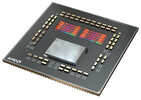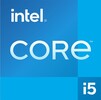AMD Ryzen 7 5800X vs Intel Core i5-14501E vs Intel Core i7-13700K
AMD Ryzen 7 5800X
► remove from comparison
The AMD Ryzen 7 5800X is an 8-core desktop processor with Simultaneous Multithreading (SMT), which allows it to process 16 threads simultaneously. With its launch on 08.10.2020, it is the fastest 8-core processor from AMD. The second fastest 8-core processor will be the AMD Ryzen 7 3800XT, followed by the more economical AMD Ryzen 7 3700X, also with 8 cores and 16 threads.
The Ryzen 7 5800X clocks with a base clock of 3.8 GHz and reaches up to 4.7 GHz on one core in turbo mode. When all 8 cores are utilized, the AMD Ryzen 7 5800X, like the AMD Ryzen 9 5900X, achieves up to 4.5 GHz.
At first glance, the internal structure of the processor has not changed fundamentally. The CCX structure has changed somewhat compared to Zen2, because now a CCX consists of up to 8-CPU cores. So each individual core can access the complete L3 cache (32 MByte). Furthermore the CCX modules are connected to each other via the same I/O die, which we already know from Zen2. According to AMD, the Infinity-Fabric should now reach clock rates of up to 2Ghz, which in turn allows a RAM clock of 4.000 MHz without performance loss.
Performance
The average 5800X in our database is in the same league as the Core i9-10900K and also the Core i7-12700F, as far as multi-thread benchmark scores are concerned.
In games, AMD's Ryzen 7 5800X can convince with its significantly improved IPC and even put Intel in its place. With the AMD Ryzen 7 5800X, gamers are well prepared for the future as simultaneous streaming is no problem with the new Ryzen 7 5800X. Semi-professional content creators, who need even more power, can choose a Ryzen 9 5900X or the Ryzen 9 5950X on the shelf.
Power consumption
The Ryzen 7 has a default TDP (also known as the long-term power limit) of 105 W. This applies as long as the CPU runs at stock clock speeds.
Ryzen 7 5800X is built with TSMC's 7 nm process; as rumors have it, the I/O die is manufactured separately on the 12 nm Global Foundries process.
Intel Core i5-14501E
► remove from comparison
The Intel Core i5-14501E is a peculiar Raptor Lake family desktop processor (SoC) that has 6 performance cores but 0 efficient cores. It's the lack of E-cores that makes 14X01 chips special.
The product has decently sized level 2 and 3 caches at 12 MB and 24 MB, respectively. Its CPU cores run at up to 5.2 GHz. The UHD 770 serves as the integrated graphics solution. There is no 'proper' NPU here, however, vPro Enterprise features such as RPE (Remote Platform Erase) are onboard.
The i5 chip is manufactured built with the Intel 7 process which is fairly old, as of mid 2025. Its base TDP sits at 65 W which is the standard value for desktop CPUs.
Performance
While we have not tested a single 14X01 processor as of July 2025, we do know that a single 4.6 GHz Raptor Cove core, such as that of an Core i7-14650HX is good for 116 Cinebench 2024 points and 285 Cinebench R15 points. (The 14501E can run at up to 5.2 GHz, too, to remind you.) If we multiply the values by 6, we get a reasonably fair projection that sees the 14501E being about as fast as lower mid-range laptop AMD chips of 2025, such as the AMD Ryzen AI 5 340. While not particularly impressive, this is definitely sufficient for any tasks and applications one could run in 2025, top games included.
Intel Core i7-13700K
► remove from comparison
The Intel Core i7-13700K is a high-end CPU based on the current Raptor Lake architecture, which was introduced in September 2022. The base clock is 3.4 GHz and can reach up to 5.4 GHz under optimal conditions. The total of 16 cores are divided into 8 P-cores and 8 E-cores, which we already know from the Alder Lake architecture. Compared to the Intel Core i7-12700K, however, the number of E-cores has been doubled, meaning that the Intel Core i7-13700K now offers 24 threads. As usual, the K models continue to offer a freely selectable multiplier, which simplifies overclocking. In addition, all new Raptor Lake processors can be operated on the existing Socket 1700 motherboards.
Performance
Compared to the Intel Core i7-12700K, the Core i7-13700K still offers 8 P-cores, but these are to be relieved by 8 additional E-cores for demanding applications. The E-cores primarily take care of background applications. The hybrid architecture relies on the Intel Thread Director, which is responsible for the correct allocation of tasks. Compared to Alder Lake, the number of e-cores has been doubled, which significantly improves multi-thread performance in combination with a further increase in IPC. If all requirements are met, Intel Turbo Boost 3.0 can increase the clock rate of the P-cores to up to 5.4 GHz. The E-cores can also be overclocked and reach a maximum of 3.4 GHz.
Graphics
Like the Intel Core i7-12700K, the Intel Core i7-13700K offers an integrated graphics unit (iGPU). The Intel Iris Xe architecture continues to serve as the basis. In terms of performance, however, not much has changed with the new Intel UHD Graphics 770.
Power Consumption
The Intel Core i7-13700K is specified with a TDP of 125 watts, which corresponds to the PL1 value. In Boost mode, the processor's performance can increase to up to 253 watts (PL2). However, this requires good cooling. If all restrictions are deactivated in the BIOS, the PL2 value is not restricted by a Tau value.
| Model | AMD Ryzen 7 5800X | Intel Core i5-14501E | Intel Core i7-13700K | ||||||||||||||||||||||||||||||||||||||||||||||||||||||||||||||||||||||||||||||||||||||||
| Codename | Vermeer (Zen 3) | Raptor Lake | Raptor Lake | ||||||||||||||||||||||||||||||||||||||||||||||||||||||||||||||||||||||||||||||||||||||||
| Series | AMD Vermeer (Ryzen 5000) | Intel Raptor Lake-S | Intel Raptor Lake-S | ||||||||||||||||||||||||||||||||||||||||||||||||||||||||||||||||||||||||||||||||||||||||
| Series: Raptor Lake-S Raptor Lake |
|
|
| ||||||||||||||||||||||||||||||||||||||||||||||||||||||||||||||||||||||||||||||||||||||||
| Clock | 3800 - 4700 MHz | 3300 - 5200 MHz | 3400 - 5400 MHz | ||||||||||||||||||||||||||||||||||||||||||||||||||||||||||||||||||||||||||||||||||||||||
| L1 Cache | 512 KB | ||||||||||||||||||||||||||||||||||||||||||||||||||||||||||||||||||||||||||||||||||||||||||
| L2 Cache | 4 MB | 12 MB | 24 MB | ||||||||||||||||||||||||||||||||||||||||||||||||||||||||||||||||||||||||||||||||||||||||
| L3 Cache | 32 MB | 24 MB | 30 MB | ||||||||||||||||||||||||||||||||||||||||||||||||||||||||||||||||||||||||||||||||||||||||
| Cores / Threads | 8 / 16 | 6 / 12 6 x 5.2 GHz Intel Raptor Cove P-Core | 16 / 24 8 x 5.4 GHz Intel Raptor Cove P-Core 8 x 3.4 GHz Intel Gracemont E-Core | ||||||||||||||||||||||||||||||||||||||||||||||||||||||||||||||||||||||||||||||||||||||||
| TDP | 105 Watt | 65 Watt | 125 Watt | ||||||||||||||||||||||||||||||||||||||||||||||||||||||||||||||||||||||||||||||||||||||||
| Technology | 7 nm | 10 nm | 10 nm | ||||||||||||||||||||||||||||||||||||||||||||||||||||||||||||||||||||||||||||||||||||||||
| Die Size | 2 x 80.7 sq. mm; I/O = 125 mm2 | 257 mm2 | |||||||||||||||||||||||||||||||||||||||||||||||||||||||||||||||||||||||||||||||||||||||||
| max. Temp. | 90 °C | 100 °C | |||||||||||||||||||||||||||||||||||||||||||||||||||||||||||||||||||||||||||||||||||||||||
| Socket | AM4 (LGA1331) | LGA1700 | LGA 1700 | ||||||||||||||||||||||||||||||||||||||||||||||||||||||||||||||||||||||||||||||||||||||||
| Features | DDR4-3200 RAM, PCIe 4, MMX (+), SSE, SSE2, SSE3, SSSE3, SSE4.1, SSE4.2, SSE4A, AES, AVX, AVX2, FMA3, SHA | DDR4-3200/DDR5-4800 RAM, PCIe 5 + PCIe 4, DL Boost, GNA, vPro En., RPE, MMX, SSE, SSE2, SSE3, SSSE3, SSE4.1, SSE4.2, AVX, AVX2, BMI2, ABM, FMA, ADX, SMEP, SMAP, EIST, TM1, TM2, HT, Turbo, SST, AES-NI, RDRAND, RDSEED, SHA | Intel UHD Graphics 770, DDR5 5600 MT/s, DDR4 3200 MT/s | ||||||||||||||||||||||||||||||||||||||||||||||||||||||||||||||||||||||||||||||||||||||||
| Architecture | x86 | x86 | x86 | ||||||||||||||||||||||||||||||||||||||||||||||||||||||||||||||||||||||||||||||||||||||||
| $449 U.S. | $409 U.S. | ||||||||||||||||||||||||||||||||||||||||||||||||||||||||||||||||||||||||||||||||||||||||||
| Announced | |||||||||||||||||||||||||||||||||||||||||||||||||||||||||||||||||||||||||||||||||||||||||||
| Manufacturer | www.amd.com | www.intel.com | www.intel.de | ||||||||||||||||||||||||||||||||||||||||||||||||||||||||||||||||||||||||||||||||||||||||
| iGPU | Intel UHD Graphics 770 ( - 1550 MHz) | Intel UHD Graphics 770 (300 - 1600 MHz) |
Benchmarks
Average Benchmarks AMD Ryzen 7 5800X → 0% n=0
Average Benchmarks Intel Core i7-13700K → 0% n=0
* Smaller numbers mean a higher performance
1 This benchmark is not used for the average calculation












